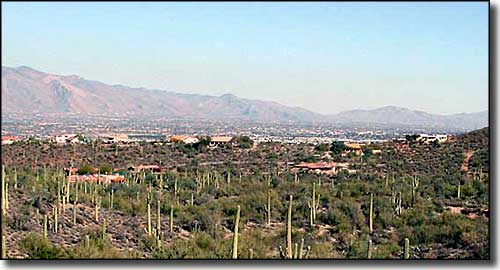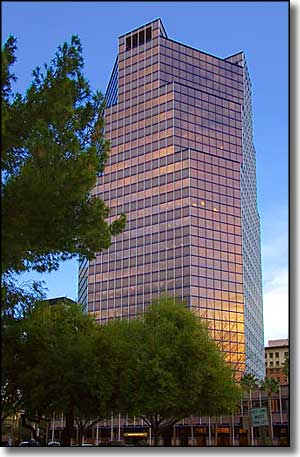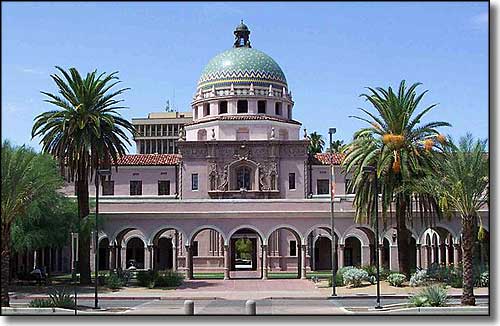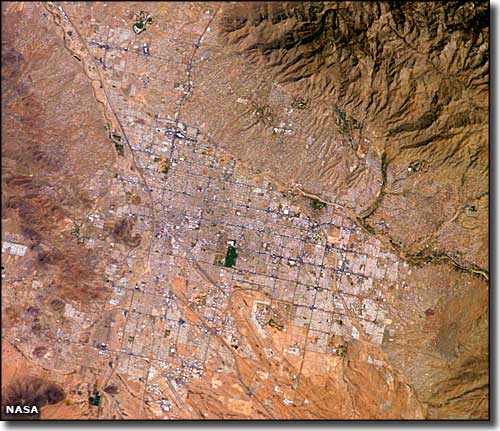
Tucson, Arizona

Looking east across the northwest side of Tucson

The Presidio at Tucson was established by the Spanish on August 20, 1775. The area became part of Mexico after Mexico declared independence from Spain in 1820. The Mormon Battalion traveled through Tucson in 1846 on their way to California during the Mexican-American War. The Treaty of Guadalupe-Hidalgo in 1848 left Tucson in Mexican hands but in the Gadsden Purchase of 1853, the area down to Nogales became part of the United States, although the American military didn't arrive to take possession until March, 1856. Tucson was capital of the Confederate Arizona Territory from August, 1861, until mid-1862. Tucson was the capital of Arizona Territory from 1867 to 1879, when the capital was moved back to Prescott before finally being moved to Phoenix. In those days, Tucson was the largest city and commerical area in Arizona. Phoenix was the center of agriculture for the state and the seat of state government but the population and commercial importance of Phoenix lagged Tucson's until the late 1920's. Since then, Phoenix has expanded rapidly while Tucson has grown steadily but at a slower pace.
Tucson is located on an alluvial plain in the Sonoran Desert, surrounded by 5 mountain ranges: the Santa Catalinas and Tortolitas to the north, the Rincons to the east, the Santa Ritas to the south and the Tucsons to the west. On the east and the southwest sides of town are the 2 sections of Saguaro National Park.
Chartered in 1885, the main campus of the University of Arizona is located in Tucson. Tucson was built on a grid system with the center of town originally located at the corner of Broadway Boulevard and Stone Avenue. However, the population has grown extensively since those early days and the city now extends very far to the east and north, and to the south far enough that Tucson actually surrounds the city of South Tucson. This alluvial plain between the mountain ranges is now so built up that the suburbs extend up the valleys between the mountains and in some places, starts to surround those mountains on their other sides.
Tucson has a water supply problem in that most water used in the city comes from either local groundwater sources or via an aqueduct from the Central Arizona Project. In the early 1990's the CAP water started to drop in quality and is now most often delivered to customers only after being mixed with local groundwater. The problem is that the aquifer beneath the city is slowly being drained by the burden placed on it by all those people. 100 years ago, the Santa Cruz River almost always flowed through Tucson year-round, but that supply of surface water has literally disappeared into the ground as the aquifer has been drained down.
On the southeast side of Tucson is Davis-Monthan Air Force Base. While the most active part of the base is the flight training area, you'll find thousands of moth-balled aircraft parked here. Most airports need concrete 8' (or more) thick to park aircraft on but in Tucson, the desert floor is so hard-packed the aircraft are parked directly on the dirt.
I lived in Tucson in 1968 and again in 1974-75. One of the local traditions occurred in early May in those days: representatives from the city tourism board would step out on a sidewalk in downtown and cook an egg by cracking the egg open and allowing it to fry directly on the concrete in the morning sun. In those days, the city was only half the size it is now. Quoting Tucson Mayor John Corbett, Life Magazine named Speedway Boulevard the "ugliest street in America" back then (and in 1968, I lived just a few blocks north of Speedway near Wilmot on what was then the northeast edge of the city). In 1968, Tucson's School District #1 had 2 of the top-ten best rated high schools in America. By the mid-1970's those ratings were dropping as Arizona invested more money in building prisons and less in education. I was back in Tucson for a few days in 1993 and almost didn't recognize the city: it had grown far beyond the boundaries I knew. And getting around in town was much harder than before as many streets had been turned into one-ways and quite a few had become bicycle-only, especially in the University area.

The old Pima County Courthouse, now County Clerk & Recorder's Offices

An astronaut's view of Tucson
Zip Codes: 85701-85726, 85728, 85730-85737, 85740-85752, 85754, 85775, 85777
Latitude: 32.2217
Longitude: -110.9264
Incorporated: 1877
Elevation: 2,389'
Education:
High School or Higher: 80.4%
Bachelor's Degree or Higher: 22.9%
Graduate or Professional Degree: 9.0%
2011 Cost of Living Index for Tucson: 89.9
Estimated Median Household Income: $35,600
Estimated Median Home Value: $162,400
Median Resident Age: 32.1 Years
Major Industries:
Health Care, Educational Services, Lodging & Food Services, Professional Services, Waste Management Services, Construction, Government, Social Services, Finance & Insurance Services
Unemployed (March 2011): 9.4%
2010 Population Demographics
| Total Population | 520,116 |
| Males | 257,312 |
| Females | 262,804 |
| Population by Age | |
| Under 18 | 121,364 |
| 18 & over | 398,752 |
| 20-24 | 52,541 |
| 25-34 | 77,775 |
| 35-49 | 96,675 |
| 50-64 | 88,044 |
| 65 & over | 61,893 |
| Population by Ethnicity | |
| Hispanic or Latino | 216,308 |
| Non Hispanic or Latino | 303,808 |
| Population by Race | |
| White | 362,649 |
| African-American | 26,000 |
| Asian | 14,920 |
| Native American | 14,154 |
| Hawaiian or Pacific Islander | 1,147 |
| Other | 79,239 |
| Two or more | 22,007 |
